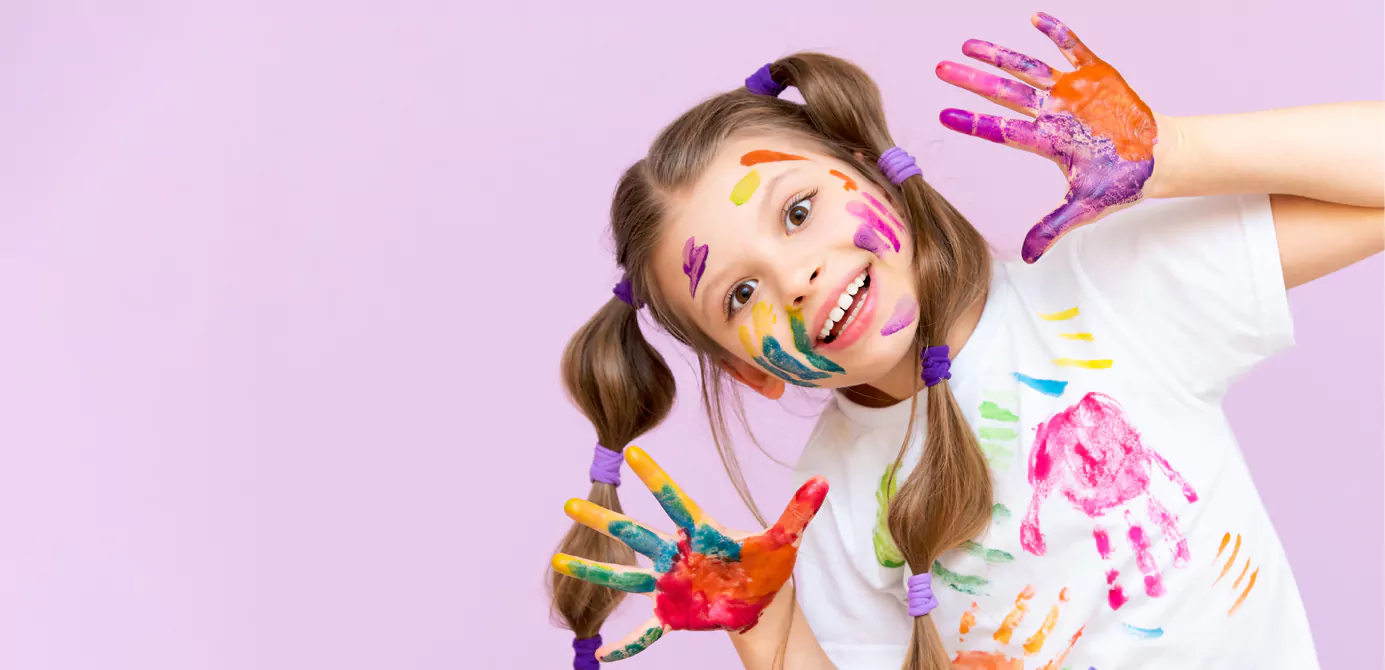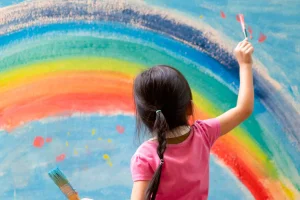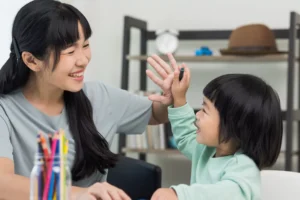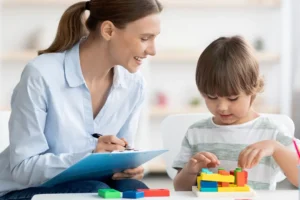Benefits of Art and Craft Workshops in Child Development
![]()

Art and craft workshops for young children play an important role in their early education and deliver tremendous long-term value by ensuring higher levels of emotional, physical, cognitive, social, cultural and creative maturity, opening doors to opportunities that would have otherwise remained shut.
The benefits of art and craft in early childhood can be noticed almost immediately. Parents will notice an eagerness in their children to participate in art and craft play activities that may be difficult to match. Children will be thrilled to engage and explore visual and other sensory experiences and learn how to recognise and communicate ideas and meanings easily using the skills they learn in art and craft workshops.
Whether it’s playing and sculpting miniatures out of clay or colouring with crayons, making origami shapes from paper or crafting handmade facemasks or birthday cards for parents and friends, art and craft workshops provide numerous creative opportunities to children to freely express themselves.
Involving in Art and craft activity helps children develop their fine motor skills and hand-eye coordination by requiring them to exercise the small muscles in their hands and fingers. These skills are necessary for tasks such as writing, eating and taking care of themselves as they grow up.
Spend quality time together

Art and craft workshops are a great way to spend quality time with family as children tend to express and share their ideas with them freely, actively seeking their help. As the frequency of these interactions multiplies, it strengthens the bond between children and their parents and caregivers. As a bonus, parents also end up creating a repository of art and craft that helps bring back fond memories of their children growing up.
In life ‘knowing how’ is just as important as ‘knowing why’. Art and craft introduce children to a range of intellectual and practical skills. Helping young become lifelong learners by exposing them to frequent opportunities to think out of the box and develop confidence in other subjects and pick up life skills.
The benefits of art and craft in early childhood play a crucial role as these benefits will be at the centre of science, technology, engineering and mathematics (STEAM). They also provide an introduction to potentially lucrative careers in the visual arts, digital and design and new media industries, sectors that contribute significantly to the economy and reputation of a country on the competitive international world-class platform.
Boost cognitive skills

Benefits of arts and crafts include helping improve cognitive development in children by sparking their creativity and imagination. By providing your child with different materials to work with, you will be giving her an opportunity to let her imagination run wild and to start building those all-important creative thinking skills for later use in life.
Studies confirm that a child who is exposed to the arts acquires a special ability to think creatively, be original, discover, innovate, and create intellectual property — key attributes for individual success and social prosperity in the twenty-first century. “Art is not just art, it is communication, inspiration, point of view, and a bridge that links us all up.” – Chung Kei Ting in Hong Kong [Source]
Improve self-expression & self-esteem

Most people think of art as something children do just for fun. However, art plays a very important role in a child’s emotional development. Through art, children learn how to express their emotions, cope with stress, and interact with other people in a healthy manner.
Arts and crafts workshops help children find new ways to express themselves in new ways and build on their self-esteem and self-worth. Art is an extremely valuable activity for children of all ages as it helps develop a core sense of self-esteem — vital for every child.
Spark creativity & imagination

Creativity and imagination are two skills that arts and crafts workshops help manifest in children. By giving them the opportunity to be creative and use their imaginations, arts and crafts can help foster a love of creativity that will last a lifetime, as well as help them generate new ideas and find new solutions in all aspects of life.
Teach problem-solving skills

Arts and crafts workshops help children learn how to come up with solutions, as the projects they work on lead them to think outside the box and come up with new ways of completing a task. Children learn how to brainstorm, consider all possible solutions, and create an action plan. These skills teach children how to problem solve effectively, an important skill for success in both life and at work.
Help practise mindfulness

Art and craft workshops help children practise mindfulness, as they show how a child can bring her attention to the present moment. Practising mindfulness helps children become more aware of their thoughts, feelings, and body sensations. It also helps them learn how to control their reactions to stress and emotions.
This is also why art and craft is important in early years: When children learn to focus their attention on the present moment, they become less impulsive and more aware of their own feelings, be able to lower stress and minimise anxiety levels. When mindfulness is learned early in life, children are able to regulate their emotions when interacting with immediate peers and adults later in life.
Teaching a child to be mindful by showing her deep breathing techniques helps them relax and focus. Deep breathing resets the nervous system. Mindful awareness of breathing helps to support your child’s mental health and minimises negative self-talk.
Encourage teamwork & socialisation

Art and craft workshops encourage interactions, teamwork and socialisation in children as this requires children to work together and find common ground to complete a task. This helps children learn how to cooperate and get along with others, as well as make new friends.
Teamwork and socialisation skills are vital as they help children form lasting relationships and allow them to be successful in both their personal and professional life.
Learn flexibility

Flexibility, is among the first important life skills children pick up from art and craft workshops. This is because children begin to see the need to come up with new solutions when things don’t go as planned.
This will help them in other areas of their lives as unexpected situations will no longer throw them off balance. Instead, they will learn to pick themselves up, adapt quickly to changing situations, and develop the ability to expect the unexpected.
Fun Art & Craft activities for children

As a child’s brain is constantly learning and growing, it is important to provide your child with a wide range of art and craft supplies that can stimulate her interest and keep her engaged. The more diverse the range of art materials you source, the easier it will become to create more opportunities to learn and grow.
Arts and craft workshops are helpful in fostering the development of specific motor, cognitive, linguistic, and pre-academic skills. They also allow for interpersonal exchanges that are vital for brain development, lifelong learning, and social-emotional competence. Art and craft activities for children allow them to be creative, think outside the box, and solve problems.
Creating a ‘worry’ doll:
A ‘worry’ doll is a small toy you can help your child create so that she can then pass all her worries to the doll. Psychologically, a doll becomes a useful device to help children become more aware and mindful of their emotions, feelings and worries.
These dolls are easy to make, all you need is toothpicks or pipe cleaners, spools of knitting wool and colourful twine to make tiny ‘worry’ dolls. Involve your child by talking about worry dolls and how they might be useful to her.
Help your child gather all of the materials you need to make the ‘worry’ doll. Once she has collected everything she needs, show her how to make one. Let your child decide how many ‘worry’ dolls she wants to make.
While she is engaged in making the first one, give your child the background as to why she is making one for herself. Explain to your child that everyone has worries and it will be OK to tell you about them, or in your absence, share them with her ‘worry’ doll.
Show her how she can do this effectively. Ask your child to focus on her breathing and spend a few minutes talking to the doll about her worries. Transferring them to her doll and asking her to take care of them. She can then put away her dolls until she needs them doll again.
Painting & Drawing:
Painting, doodling and drawing are activities that provide a wealth of development benefits for children. They make children creative, help them explore their imagination, and improve their dexterity and coordination, all at the same time.
Plus, it is not expensive. All that you would need is a piece of paper and some crayons or paint. Another big benefit art and craft activities bring to young children are helping them focus on fine motor skills as they begin experimenting with a variety of fabrics, materials, colours and things of different shapes and sizes.
As children learn to handle a pair of scissors safely, cut and paste, hold crayons or anything else, they are actually strengthening their muscles and improving dexterity and learning to coordinate their eyes and hands. It is a fun, absorbing, colourful, and liberating experience. Little wonder then, why children enjoy art and craft workshops so much.
Using nature to nurture:
It is important for children to initiate and develop activities for themselves. They must have opportunities to revisit and practise their physical skills in ways meaningful to them to build confidence and independence. For instance, it is very important for children to learn about nature.
For instance, creating a nature collage consisting of leaves, flowers, and twigs and use naturally occurring material that they take a fancy to. Hand painting rocks and tiles, using wooden sticks to build houses, cutting leaves dipping them in paint and using it to print patterns on a cloth or paper among many others…
The best learning is when a child is relaxed, absorbed in her surroundings collecting things she would need to make a nature collage. Having so much fun while playing, she doesn’t even realise that she’s picking up new skills. That’s the real magic of the art and craft workshops.
Creating a tiger mask:
Children love making masks of their favourite animals and superheroes. My child’s favourite animal is the tiger and it was time to create a mask for her to wear to a birthday party.
First, we got hold of a large piece of cardboard and as my child was too young to work with a pair of scissors, I helped her cut the board into the shape of a tiger’s face and ears. Made sure this would cover her face snugly and used an elastic band to hold it in place.
Then we began to colour the board with bright yellow as a background first. Drew four long outlines of stripes on either sides of the tiger’s nose in pencil and asked my child to fill in the outline with black. Finally, we used white paint to complete the jaws and mouth. The birthday facemask would be ready for the party once the paint dried.
Painting the tiger mask was good for helping my child with her fine motor skills, taught her turn-taking (with the brushes), improved her self-confidence. She also learned how to paint around the eyeholes developing her control, as well as learning that the flatter brush covered more of the mask faster.
Discovering the magic of colours:
When your child begins to experiment with colours, she in effect is practising science thinking skills such as cause and effect, learning to predict what can happen, and comparing the results.
Introduce blue, red, and yellow as the “primary colours.” To teach colour matching, help your child combine paints in different colours (mixing red and blue to make purple paint). While taking her through the steps of mixing colours, you will be introducing new words and contexts, enhancing your child’s communication and linguistic skills.
While viewing the resulting colour combinations, discuss the concept of “secondary colours,” including green, orange, and purple. Your child can also make artwork with shades of colour she created. Doing activities with colour offers children a sense of accomplishment along with a great deal of fun.
Another big benefit is getting your child to use different tools such as droppers, brushes, sponges, craft sticks, and fingers! This way you will encourage further development of her fine motor skills, hand-eye coordination and visual judgement.
About Abrakadoodle
Process Art learning experiences inspire toddlers and young children to think different, be innovative, and explore new ways to learn about interesting things found in the real world. Changing the way a child discovers and imagines. Igniting her mind to think, play and learn like never before.
If you like to enrol your child in our art and craft workshops or find out why creativity is important in early childhood education, give Abrakadoodle a call. Or better still, make an appointment with the head of a centre near you. Get hands-on exposure to an experience that will make you see art in a way that adds value to your child’s life.
Please note: Abrakadoodle classrooms are thoroughly sanitized every day — the tables, the chairs, the children’s activity stations and everything else the child might touch is made safe and clean. They also wear a mask, wash their hands frequently, and practice social distancing.
Frequently Asked Questions
What is the importance of art for child development?
The following are some of the benefits of art in early childhood development:
– Children become more inclined towards learning new things
– It encourages sensory exploration
– They gain the confidence to communicate their thoughts and ideas freely
– It promotes better interactions with peers and family
– It flexes their fine muscles and improves hand-eye coordination
– It also stimulates cognitive development in children
What does a child learn from art?
One of the most important skills a child learns through art is the ability to express his or her emotions, which opens them up to new ideas and lessons.
The benefits of an art workshop for children include:
1. It strengthens their bonds with friends and peers.
2. It enhances their intellectual capabilities.
3. It helps them recognize their own feelings and emotions.
4. It allows their emotions to run wild and manifest in reality.
5. It allows them to brainstorm and practice problem-solving.
What skills does art develop in children?
An art and craft workshop plays an important role in child development as it helps toddlers acquire the following skills:
– Hand-eye coordination
– Literary skills
– Cognitive skills
– Problem-solving
– Social skills
– Creativity
– Flexibility
How does arts and crafts help a child’s social development?
Through arts and crafts workshops, children experience an enriching session where they spend time with friends, work as a team, and create incredible artworks together. As part of collaborative exercises, they are given the opportunity to express their ideas while also being encouraged to understand the perspectives of their peers. They not only make new friends, but they also learn to work together as a team to accomplish a creative task.
Why art and craft is important in education?
Arts and crafts workshops stir up creativity in early childhood education. Art activities shape a child’s personality, foster social skills, and allow them to brainstorm and come up with creative solutions to problems, in addition to stimulating cognitive development in children. Art education also boosts a child’s self-confidence and enhances their self-esteem.
![]()



